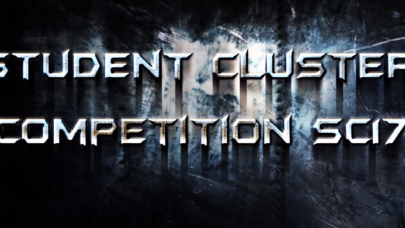
URISC@SC17 and the #LongestLastMile
January 11, 2018
A multinational delegation recently attended the Understanding Risk in Shared CyberEcosystems workshop, or URISC@SC17, in Denver, Colorado. URISC participants and presenters from 11 countries, including eight African nations, 12 U.S. states, Canada, India and Nepal, also attended SC17, the annual international conference for high performance computing, networking, storage and analysis that drew nearly 13,000 attendees. Read more…

As Exascale Frontier Opens, Science Application Developers Share Pioneering Strategies
December 19, 2017
In November 2015, three colleagues representing the US Department of Energy (DOE) Office of Science’s three major supercomputing facilities struck up a conver Read more…

SC17 Cluster Competition: Who Won and Why? Results Analyzed and Over-Analyzed
November 28, 2017
Everyone by now knows that Nanyang Technological University of Singapore (NTU) took home the highest LINPACK Award and the Overall Championship from the recently concluded SC17 Student Cluster Competition. We also already know how the teams did in the Highest LINPACK and Highest HPCG competitions, with Nanyang grabbing bragging rights for both benchmarks. Read more…

SC17 US Student Cluster Competition Teams: Defending the Home Turf
November 24, 2017
Nine US universities showed up to the SC17 Student Cluster Competition in an attempt to keep the trophies in the United States. Let’s use our video lens to ge Read more…

Long Flights to Cluster Fights: Meet the Asian Student Cluster Teams
November 22, 2017
Five teams from Asia traveled thousands of miles to compete at the SC17 Student Cluster Competition in Denver. Our cameras were there to meet ‘em, greet ‘em Read more…

Perspective: What Really Happened at SC17?
November 22, 2017
SC is over. Now comes the myriad of follow-ups. Inboxes are filled with templated emails from vendors and other exhibitors hoping to win a place in the post-SC thinking of booth visitors. Attendees of tutorials, workshops and other technical sessions will be inundated with requests for feedback. Read more…

Live and in Color, Meet the European Student Cluster Teams
November 21, 2017
The SC17 Student Cluster Competition welcomed two teams from Europe, the German team of FAU/TUC and Team Poland, the pride of Warsaw. Let's get to know them bet Read more…

SC17 Student Cluster Kick Off – Guts, Glory, Grep
November 21, 2017
The SC17 Student Cluster Competition started with a well-orchestrated kick-off emceed by Stephen Harrell, the competition chair. It began with a welcome from Read more…

- Click Here for More Headlines

Whitepaper
Transforming Industrial and Automotive Manufacturing
In this era, expansion in digital infrastructure capacity is inevitable. Parallel to this, climate change consciousness is also rising, making sustainability a mandatory part of the organization’s functioning. As computing workloads such as AI and HPC continue to surge, so does the energy consumption, posing environmental woes. IT departments within organizations have a crucial role in combating this challenge. They can significantly drive sustainable practices by influencing newer technologies and process adoption that aid in mitigating the effects of climate change.
While buying more sustainable IT solutions is an option, partnering with IT solutions providers, such and Lenovo and Intel, who are committed to sustainability and aiding customers in executing sustainability strategies is likely to be more impactful.
Learn how Lenovo and Intel, through their partnership, are strongly positioned to address this need with their innovations driving energy efficiency and environmental stewardship.
Download Now
Sponsored by Lenovo
Whitepaper
How Direct Liquid Cooling Improves Data Center Energy Efficiency
Data centers are experiencing increasing power consumption, space constraints and cooling demands due to the unprecedented computing power required by today’s chips and servers. HVAC cooling systems consume approximately 40% of a data center’s electricity. These systems traditionally use air conditioning, air handling and fans to cool the data center facility and IT equipment, ultimately resulting in high energy consumption and high carbon emissions. Data centers are moving to direct liquid cooled (DLC) systems to improve cooling efficiency thus lowering their PUE, operating expenses (OPEX) and carbon footprint.
This paper describes how CoolIT Systems (CoolIT) meets the need for improved energy efficiency in data centers and includes case studies that show how CoolIT’s DLC solutions improve energy efficiency, increase rack density, lower OPEX, and enable sustainability programs. CoolIT is the global market and innovation leader in scalable DLC solutions for the world’s most demanding computing environments. CoolIT’s end-to-end solutions meet the rising demand in cooling and the rising demand for energy efficiency.
Download Now
Sponsored by CoolIT
Advanced Scale Career Development & Workforce Enhancement Center
Featured Advanced Scale Jobs:
HPCwire Resource Library
HPCwire Product Showcase
© 2024 HPCwire. All Rights Reserved. A Tabor Communications Publication
HPCwire is a registered trademark of Tabor Communications, Inc. Use of this site is governed by our Terms of Use and Privacy Policy.
Reproduction in whole or in part in any form or medium without express written permission of Tabor Communications, Inc. is prohibited.
























